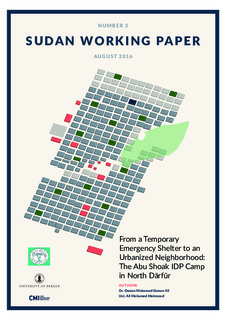| dc.description.abstract | Introduction
In early 2003, two rebel movements (the Sudanese Liberation Army and the Justice and Equality Movement) launched an insurgency against the rule in Khartoum. Supported by Janjaweed tribal militias, the government of Sudan responded with decisive counteroffensives. Mass displacement of predominantly rural people was evident from April onwards, increasing steadily throughout 2003–04. By May 2003, there were over 500 000 internally displaced persons in Greater D a rf u r, mostly in IDP camps at the edge of big towns (Minear 2004, 78). Most, if not all, of these camps still exist, because the causes that generated them are still very much present; i.e., insecurity in the rural home areas. Also to be noted is that towns have encroached on many of them.
There are many studies on IDP camps in Sudan, as shown in the subsequent paragraphs, but none of them offer longitudinal information which allows us to see processes of adaptation within a camp. The present article is a contribution towards understanding long-term transformations and how such camps end up not being temporary, as the word “camp” would suggest, but rather become permanent and part of the towns/cities they are close to.
This article is part of a longitudinal study of one group; namely, the IDPs living in the Abu Shoak camp{1} in the periphery of El-F a sher, in North Darfur State. Following earlier work on this camp, the article looks at, and traces changes in the lives of, these IDPs since the inception of their camp in 2004. Specifically, the article looks at how displaced rural families adapted to the new urban life. This effort builds upon an assumption in urban sociology; that “urbanization as a way of life wreaks profound changes in virtually every phase of social life” (Wirth 1938, 1).
Primary data was gathered for the same group of people repeatedly over the past twelve years, through field visits in 2004, 2008, 2013, and 2016. Group and i | |
